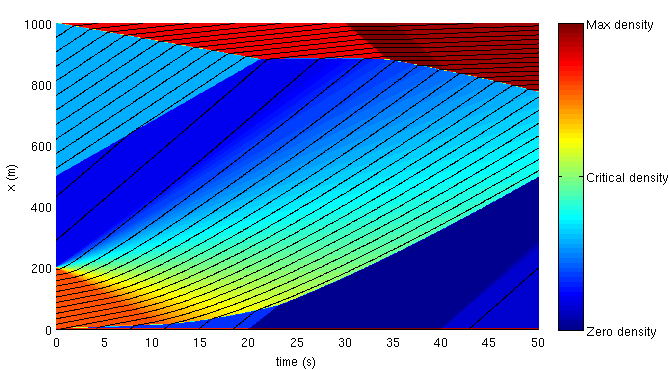MATLAB implementation of an exact LWR solver Download

The Lighthill-Whitham-Richards Partial Differential Equation (LWR PDE) is a seminal equation in traffic flow theory. It leads to common yet widely used traffic flow models for highways. This package proposes a sample implementation for a LWR solver using a new Lax-Hopf method. In the literature, the LWR PDE is typically solved using the Cell Transmission Model (CTM), a Godunov scheme, which requires a grid to compute the solution numerically, and induces specific approximations of the solution (in addition to the errors of the numerical computation).
The proposed approach has the following features:
- It is greed free: in order to compute the value at a given point x and a given time t, it is not necessary to grid space and time (only to prescribe initial and boundary data, and to enter the point where the solution should be computed).
- It is exact: the program presented here computes the solution by evaluating a function numerically (rather than approximating derivatives of the PDE by finite differences).
- It is has small computational cost: since it is not needed to grid the space, the computation is much faster than with finite difference methods (Godunov, CTM, etc.)
To get started:
- Short manual (PDF) for the matlab package;
- Article submitted to TR-B, analytical and grid-free solutions to the Lighthill-Whitham-Richards traffic flow model,
P.-E. Mazaré, C. Claudel, A. Bayen. - Article published on ScienceDirect.com, analytical and grid-free solutions to the Lighthill–Whitham–Richards traffic flow model, P.-E. Mazaré, A. Dehwah, C. Claudel, A. Bayen.
30-second how-to
- script.m contains a sample script which creates a Lax-Hopf solver for a given Greenshields fundamental diagram and solves the Cauchy problem associated with an arbitrary set of initial densities, upstream and downstream flows;
- two functions allow you to plot your results: LH_plot3D and LH_plot2D;
- for advanced users, it is possible to solve the Cauchy problem associated with any concave fundamental diagram. Refer to the manual (PDF) for more details.
Important notes
- The Matlab functions require Matlab version R2008A or newer. They may work under earlier Matlab versions, but have not been tested.
- No additional toolboxes are required.
- By downloading this software, you agree with the license terms.
References
More details about the foundations of this method can be found in the following publications:
- Lax-Hopf based incorporation of internal boundary conditions into Hamilton-Jacobi equation. Part I: Theory, C. Claudel and A. Bayen. IEEE Transactions on Automatic Control 55(5) pp. 1142-1157, May 2010, doi: 10.1109/TAC.2010.2041976
- Lax-Hopf based incorporation of internal boundary conditions into Hamilton-Jacobi equation. Part II: Computational methods, C. Claudel and A. Bayen. IEEE Transactions on Automatic Control 55(5) pp. 1158-1174, May 2010, doi: 10.1109/TAC.2010.2045439
- Dirichlet problems for some Hamilton-Jacobi equations with inequality constraints, J.-P. Aubin, A. Bayen, P. Saint-Pierre, SIAM Journal on Control and Optimization, 47(5), pp. 2348�2380, 2008, doi:10.1137/060659569
Related work:
- A variational formulation of kinematic waves: solution methods, C. Daganzo, Transportation Research Part B, 39(10), pp. 934-950, 2005
- A variational formulation of kinematic waves: Bottleneck Properties and Examples, Daganzo, C.F. and M. Menendez , Proceedings, 16th International Symposium on Transportation and Traffic Theory (H. Mahmassani, editor) Elsevier, New York, N.Y., July 2005, pp.345-364.
- On the numerical treatment of moving bottlenecks, C. Daganzo and J. Laval, Trans Res B 39(1), 31-46 (2005).
